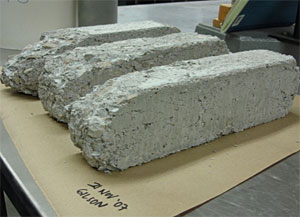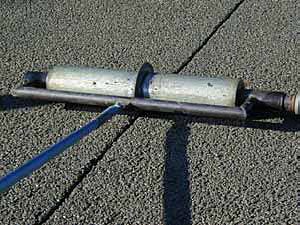Project Details
08/01/07
06/30/09
Iowa Concrete Paving Association
Iowa Department of Transportation
Researchers
Bob Steffes
Gilson Lomboy
About the research
The aim of the present study is to investigate the effect of low-permeability concrete, made with reduced watert-to-binder ratios (w/b) and/or supplementary cementitious materials (SCMs), on the need for air entrainment to achieve freezing-thawing (F-T) durability.
In the present study, concrete mixes were made with different types of cement (Types I and IP), with or without fly ash replacement (15%), with different water-to-binder ratios (w/b =0.25, 0.35, 0.45 and 0.55), and with or without air entraining agent (AEA). All concrete mixtures were controlled to have a similar slump by using different dosages of superplasticizer. The rapid chloride permeability and F-T durability of the concrete samples were determined according to ASTM C1202 and ASTM C666A, respectively. The air void structure of the concrete was studied using the Air Void Analyzer, RapidAir, and porosity tests (ASTM C642). In addition, the general concrete properties, such as slump, air content, unit weight, and 28-day compressive strength, were evaluated.
The results indicate that all concrete mixes with proper air entrainment (ASTM C231 air content ≥ 6%) showed good F-T resistance (durability factor ≥85%). All concrete mixes without AEA showed poor F-T resistance (durability factor < 40%), except for one mix that had very low permeability and high strength. This was the concrete made with Type IP cement and with a w/b of 0.25, which had a permeability of 520 coulombs and a compressive strength of 12,760 psi (88 MPa). There were clear relationships between the F-T durability and hardened concrete properties of non-air entrained concrete. However, such relationships did not exist in concrete with AEA. For concrete with AEA, good F-T durability was associated with an air void spacing factor ≤ 0.28 mm (by AVA) or ≤ 0.22 mm (by RapidAir).
Project Details
2006-01
08/01/05
02/01/06
Iowa Concrete Paving Association
Iowa Department of Transportation
National Concrete Pavement Technology Center
Researchers
Vern Schaefer
David White
Muhannad Suleiman
John Kevern
About the research
Portland cement pervious concrete (PCPC) is being used more frequently due to its benefits in reducing the quantity of runoff water, improving water quality, enhancing pavement skid resistance during storm events by rapid drainage of water, and reducing pavement noise. In the United States, PCPC typically has high porosity and low strength, which has resulted in the limited use of pervious concrete, especially in hard wet freeze environments (e.g., the Midwestern and Northeastern United States and other parts of the world). Improving the strength and freeze-thaw durability of pervious concrete will allow an increase in its use in these regions.
The objective of this research is to develop a PCPC mix that not only has sufficient porosity for stormwater infiltration, but also desirable strength and freeze-thaw durability. In this research, concrete mixes were designed with various sizes and types of aggregates, binder contents, and admixture amounts. The engineering properties of the aggregates were evaluated. Additionally, the porosity, permeability, strength, and freeze-thaw durability of each of these mixes was measured.
Results indicate that PCPC made with single-sized aggregate has high permeability but not adequate strength. Adding a small percent of sand to the mix improves its strength and freeze-thaw resistance, but lowers its permeability. Although adding sand and latex improved the strength of the mix when compared with single-sized mixes, the strength of mixes where only sand was added were higher. The freeze-thaw resistance of PCPC mixes with a small percentage of sand also showed 2% mass loss after 300 cycles of freeze-thaw. The preliminary results of the effects of compaction energy on PCPC properties show that compaction energy significantly affects the freeze-thaw durability of PCPC and, to a lesser extent, reduces compressive strength and split strength and increases permeability.
Project Details
01/01/90
01/01/90
American Concrete Pavement Association
Iowa Concrete Paving Association
Iowa Department of Transportation
Researchers
Marcia Brink
Jim Grove
Dale Harrington
Mark Anderson-Wilk
About the research
The CP Tech Notes are 12–24 page booklets with in-depth explanations and detailed illustrations on a variety of topics. The documents are convenient, reliable resources for engineers and superintendents. They are also useful for workshop leaders in developing their own training programs.
Project Details
01/01/90
01/01/90
American Concrete Pavement Association
Iowa Concrete Paving Association
Iowa Department of Transportation
Researchers
Carlo D. Smith
Jim Grove
Dale Harrington
Mark Anderson-Wilk
About the research
CP Workforce References help get basic construction information into the hands of paving crews. Each reference contains numerous illustrated subtopics and includes step-by-step recommended construction procedures, as well as precautions and tips for troubleshooting common problems. The workforce references are produced in a handy reference format and are printed in full color on a durable paper with weatherproof coating so that they can be used in the shop, vehicle, or field. These documents are excellent for training, reference, and quality control tools for foremen, crew leaders, and crews.

